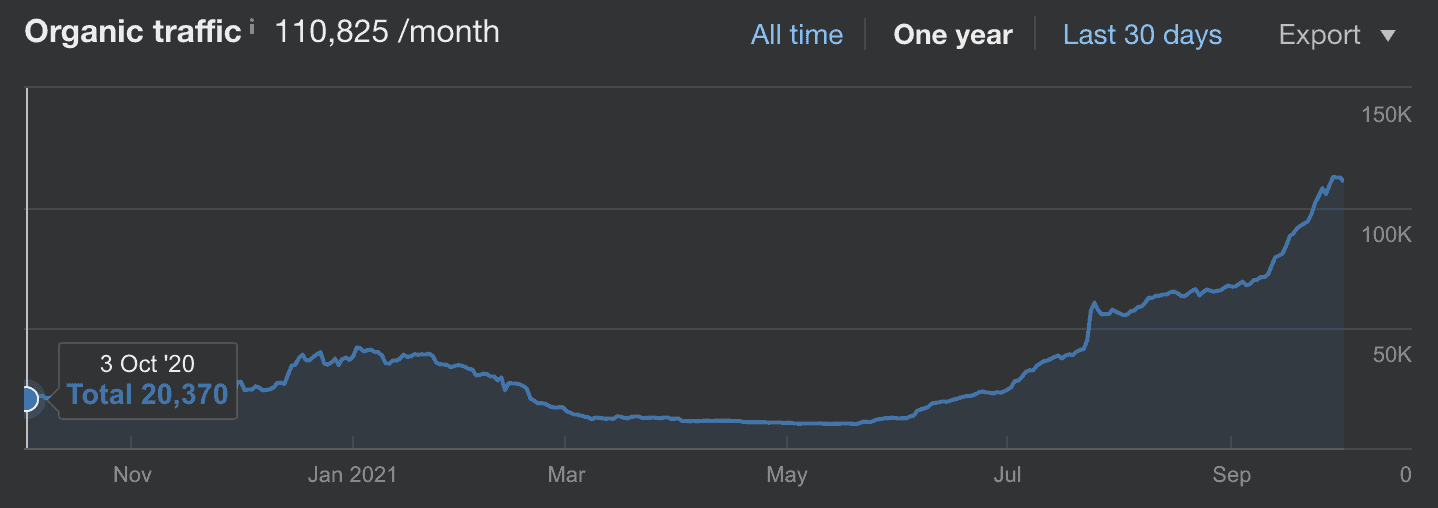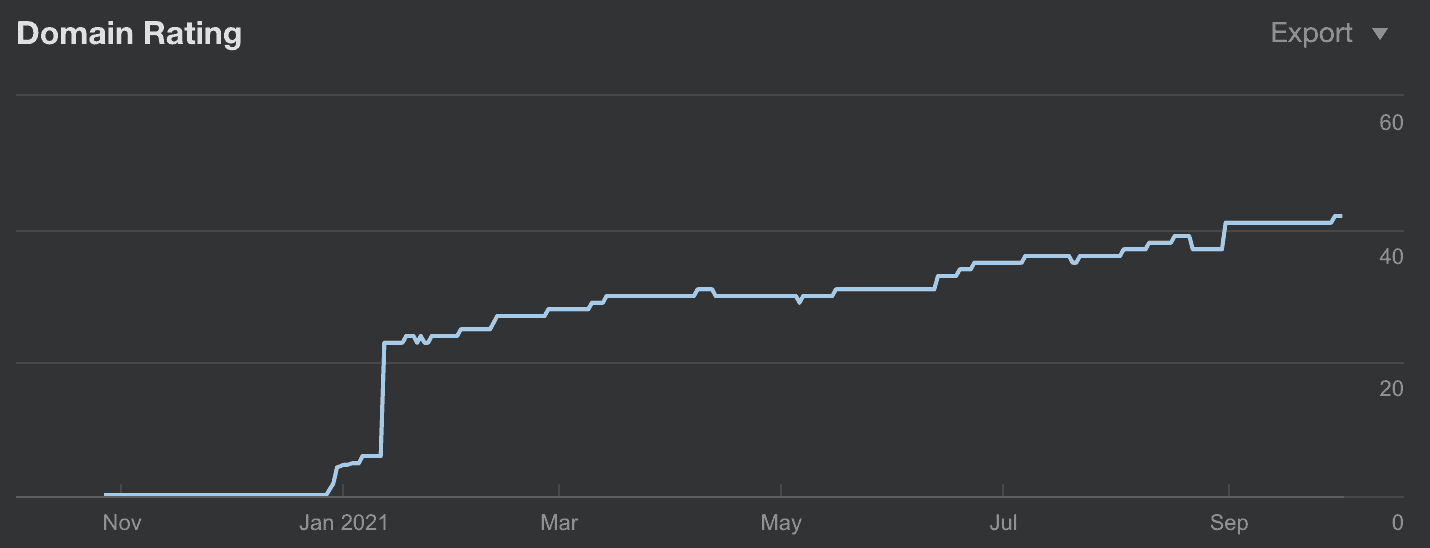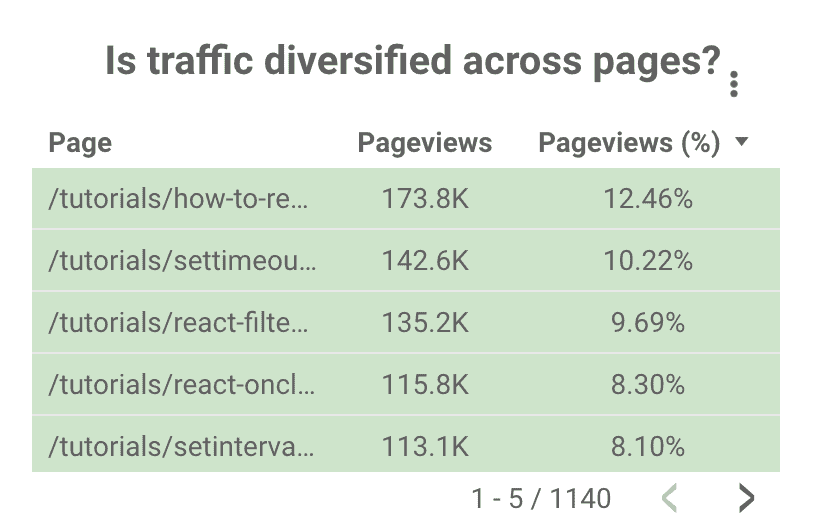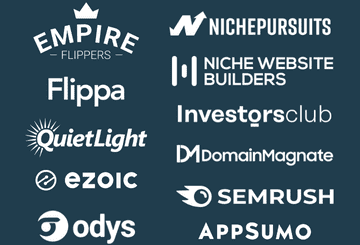Whether you are buying a site or working on an existing site in your portfolio, continuously checking the “health” of your site is critical.
The traffic increases and earnings increases only tell part of the story when analyzing a site, but they can also be hiding some potential health issues the site has. Understanding how to dig into the numbers to measure the actual health of the niche site is a critical skill.
In this write-up, I cover the following:
- 3 common ways most people gauge site health
- 4 out-of-the-box ways you should gauge health
- Reasons why I measure the health of my sites (post acquisition)
Let’s get into it!
3 Common Ways to Gauge Health
Always start with these three common ways to gauge site health. They’re not perfect, but they are a quick way to see potential winners.
1. Growing Traffic Month Other Month
Traffic growth is a very good sign. If traffic has stagnated over multiple months or even seems to be on a long downward trajectory, that’s a red flag that needs further investigation. On the other hand, if the traffic has shown steady growth month after month, that is a great sign of a healthy site.
When Google is ranking a site for more keywords, moving a site up in the rankings, or both, it shows a certain level of trust in that site.
However, I am also very critical of sites that show a large increase in traffic in a short amount of time. While this can be all-natural, oftentimes I’ve seen this exponential increase as a function of a high velocity of backlinks or a site built on aged domains.
Here’s an example:

When analyzing such a site, it’s critical to dig deep to see what was the reason for the growth. Is it because of low competition keywords? An aged domain? Combination of these things? Further analysis is needed.
2. Increased Revenues
A site that is making more than it used to is moving in the right direction. When those increased revenues are a consistent trend month after month, that is a good sign. That shows a pattern that is more common with healthy sites.
This is especially true on sites that are seeing a simultaneous jump in organic traffic numbers. If there are reports of increased traffic without increased revenue, that’s “usually” a red flag.
3. Increased Domain Rating and Authority
Setting aside arguments over how accurate DR and DA tools are, they still give an accurate range of how strong a domain’s rating is and how strong a domain’s authority is. When these numbers are going up, that’s a clear sign that keyword tools see the site as getting stronger.
A healthy site should have a stable or growing DR and DA. Here is TheWebsiteFlip.com’s DR graph from AHREFs:

This is a healthy increase over time. It’s not exponential which warrants misuse of backlinks, nor is it too flat to think why is the DR not growing.
Why The Above Is Not Enough…
These are great starting points for measuring a site. Increased traffic, increased revenues, increased DR & DA – what’s not to like? That problem is, that isn’t the full story.
There are multiple ways a site can be showing these things when the growth is actually precarious instead of healthy, solid, and sitewide.
4 Critical Ways To Gauge Health
These next steps are critical to making sure that the site is healthy and the initial numbers are telling the full story.
1. Keyword Positions #11 to #100 Stable or Growing
One of the important things to look at is keyword ranking positions. AHREFs provides a report that shows the number of keywords ranking in positions #1-#3 (top of the first page), #4-#10 (bottom of the first page), and #11-#100 (2nd to 10th page).
Here is an example of that report:
One needs to look closely when analyzing this report. At first glance, a report saying 500 new keywords at ranks #11 to #100 might be a good thing. It could mean your new content is showing up in the search results, but we need to look deeper.
If this happens while the site lost 100 positions in the top 10 spots, then suddenly that report is telling an entirely different story. Big growth in rankings from #11-100 are good if they’re coming from new content. Not if it’s coming from losing top 10 spots.
2. Diversified Traffic To Top Pages (<15%)
I like seeing diversified traffic to the top pages. Getting some snippets on Google can be powerful for organic traffic, but if that’s the only traffic, it can go away.
The top page should be (ideally) less than 15% of the total traffic. Subsequent pages, should then taper off and be diversified.
Here is a top pages report for one of my case study sites:

As you can see, the top page is less than 15% and the remaining pages are well-diversified as well.
3. Diversified Anchor Text Profile
If a backlink profile screams spam, it’s only a matter of time until the Google Manual Penalty comes down. Links to the site should naturally come in many forms including:
- the name of the general site,
- branded URL,
- words like “here” or “click here,”
- as well as a few specific keywords pointing to specific posts.
This is what a healthy link profile looks like. This is also what Google wants to see when crawling sites. A diversified anchor text profile is a good sign that the links haven’t been bought via spammy methods.
This is also a better defense from someone attempting negative SEO on the site in the future. If I see 110 backlinks and 100 say “best blue widget model Z” for anchor text, I move on.
4. Diversified Backlinks With Varying Domain Rating
No one naturally gets links from only high DR and DA domains. Likewise, a site with only links from weird random URLs online doesn’t look good.
The best backlink profiles have links with:
- Diversified anchor text
- Links from high authority, medium authority, and low authority websites
- Links from many sources (sites, forums, social media, etc.)
A diversified backlink portfolio shows content that is naturally attracting links from multiple hobbyists, webmasters, or other sources and may very well continue to do so in the future.
This looks natural, passes Google’s sniff test, and makes the site much more likely to be in a good healthy spot to not only maintain current rankings but to gain additional ones, too.
3 Reasons Why I Continuously Measure Site Health
Measuring site health isn’t a one-time thing. This is a crucial part of making sure any site in my portfolio remains healthy whether keeping it for the long-term or preparing it for a profitable flip.
Proactively Fix Any Major Critical Issues
The sooner a major issue is identified, the sooner it can be fixed. If I’m staying on top of a site’s health, this often means fixing a critical issue before it results in major traffic drops from Google penalties.
Being able to proactively fix a potentially critical issue before it explodes into a massive problem is a major benefit from staying on top of site health.
Ensure Longevity
A healthy site that always looks good when Google crawls it will only become more authoritative and trustworthy as time goes on. Making sure to fix any major issues when they come up is not only a good short-term policy, but it’s an excellent long-term policy as well.
The longer a site’s health is great, the easier it is to fix small issues that come up and stay ahead of the competition that doesn’t focus so heavily on these details.
Continuously Build A Business “Moat”
I’ve worked hard for the rankings my websites have earned, and the revenues that profitable niche sites in my portfolio provide. If my site is healthy and AHREFs gives it a high domain score like a 40, that means less competitors are going to go after those terms versus a site that only scores a 9.
Keeping a niche site in good health and gaining traffic, links, and rankings helps build defenses from competition who wants to take that traffic (and the revenues that come with it) away.
Actionable Next Steps
Many first-time and even experienced buyers only take those initial basic steps to analyze the health of a potential niche site purchase. While many buyers can even get away with this a few times, it’s bad practice.
Taking the extra four steps to critically evaluate website health is crucial to get an in-depth picture on how the site is actually doing versus how it looks like it’s doing.
Here are the next steps to implement on your existing sites:
- Keep track of your bulk keyword positions on a monthly basis using AHREFs
- Review your anchor text profile (does it look spammy?)
- Is your traffic diversified? Review in Google Analytics -> Behavior -> All Pages
Then, take the steps to start fixing these issues over time.




